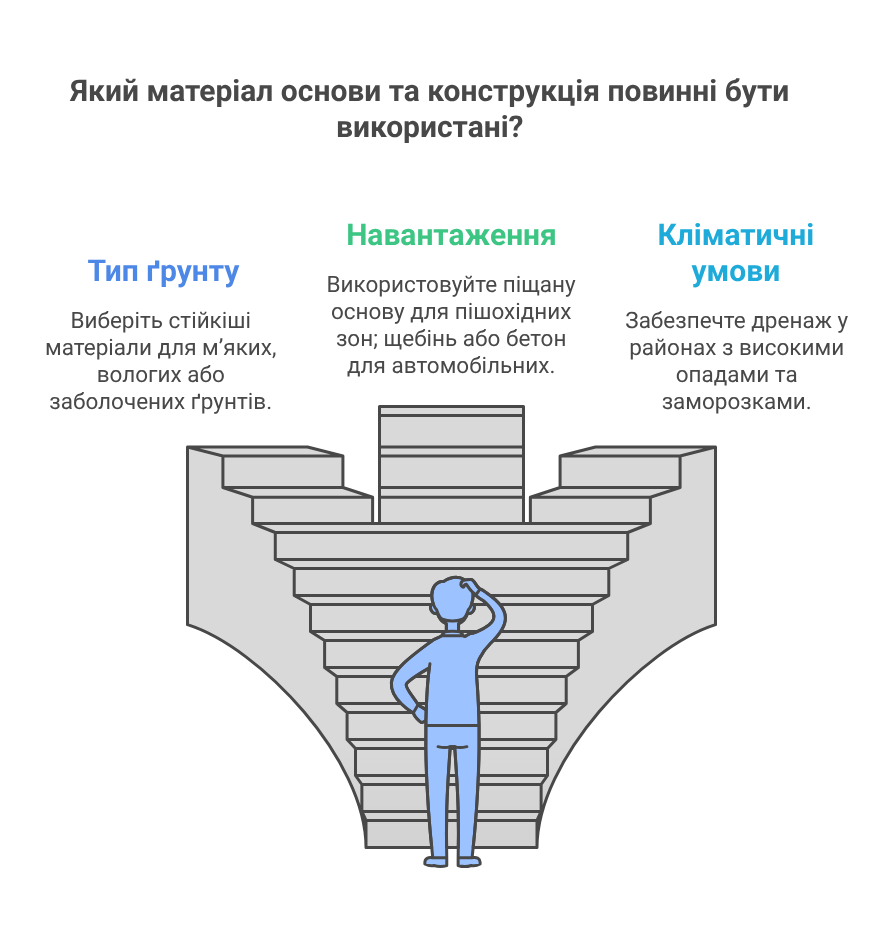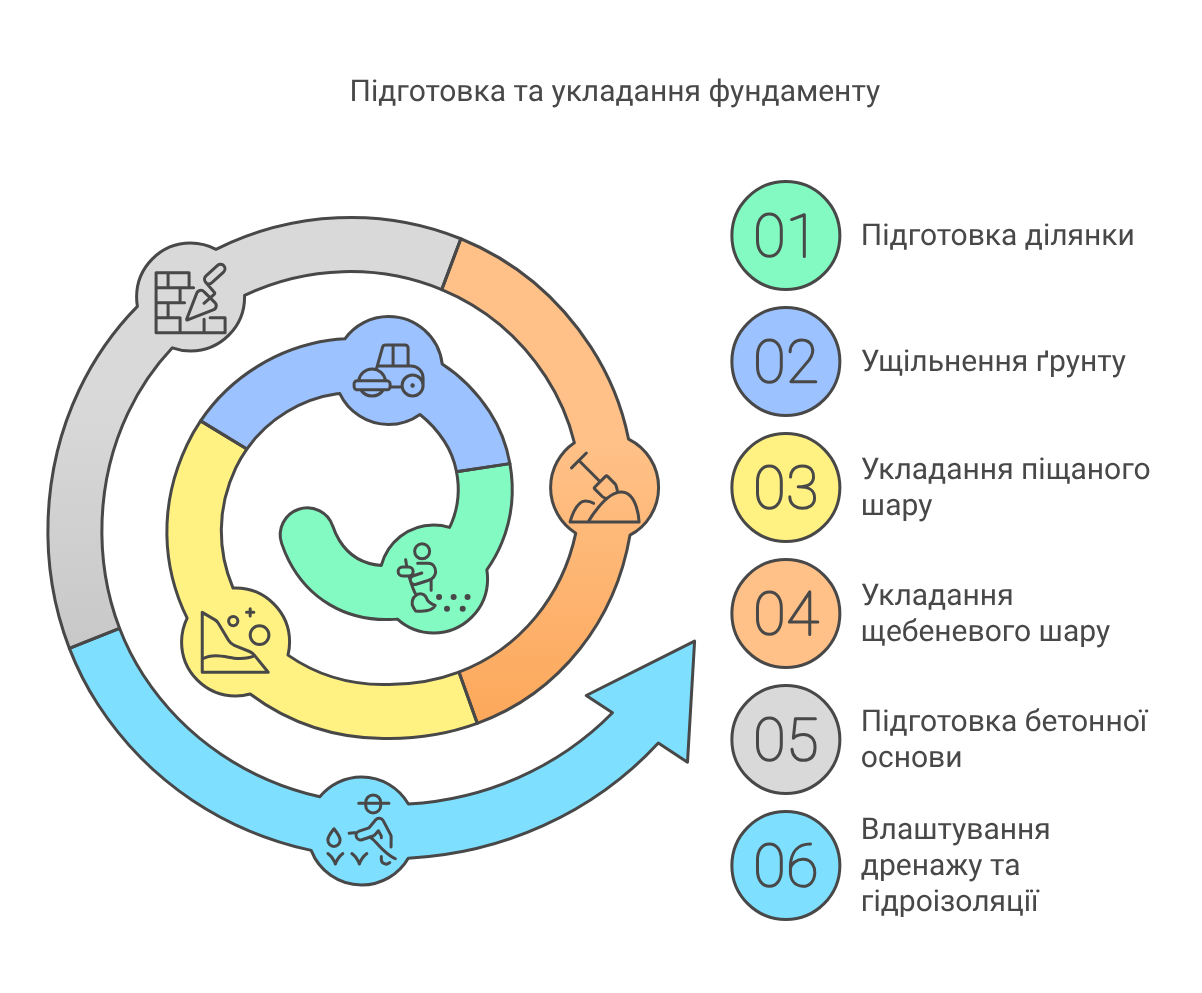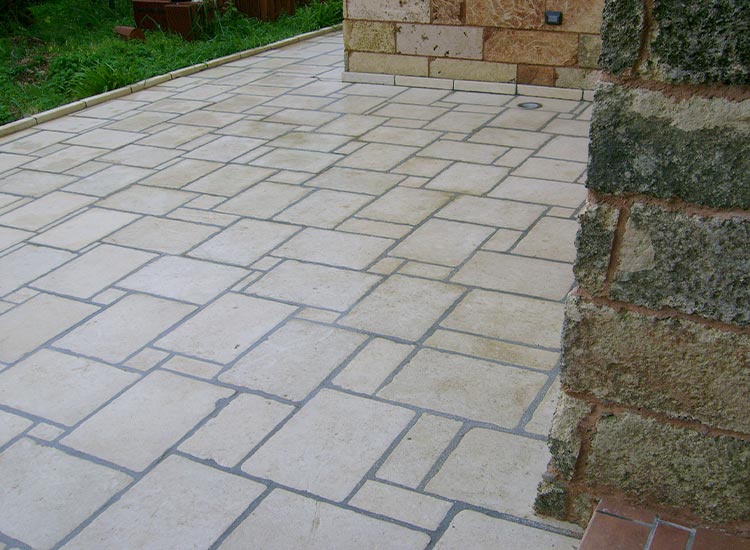Properly selected base is the key to the durability and aesthetics of your paved surface. In this guide, we will discuss what a paving base is, what types exist, how to choose the optimal option considering specific conditions and loads, and we will provide a step-by-step installation guide.
What is a paving base?
A paving base is a specially prepared layer of material on which paving stones, sidewalks, paths, and other surfaces are laid. Its main functions are:
- Providing a level and stable surface.
- Draining water, which prevents the formation of puddles and reduces the risk of surface deformation.
- Distributing the load over the entire area, ensuring durability during operation.
Choosing the right base is a primary step to achieving a quality and reliable paved surface.
Types of paving bases
The choice of material for the base depends on the operating conditions, soil type, and budget. Let’s consider the main options:
Soil base
- Description: The simplest option, where leveled and compacted soil is used directly.
- Advantages: Minimal costs.
- Disadvantages: Low moisture and temperature change resistance; risk of surface deformation.
- Recommendations: Use for pedestrian paths with light loads.
Sand base
- Description: A layer of sand (10–20 cm) is laid on compacted soil, which is also compacted.
- Advantages: Provides better drainage and even load distribution.
- Disadvantages: May require regular additional compaction.
- Recommendations: A good option for most types of paving.
Gravel base
- Description: The use of gravel allows for the creation of a strong, well-drained base.
- Advantages: High resistance to deformation, excellent water drainage, especially useful for areas with high loads.
- Disadvantages: Requires careful compaction and proper material distribution.
- Recommendations: Ideal for car and truck areas, as well as for areas with high traffic intensity.
- Search query: If you were looking for gravel for paving, this option is optimal for ensuring the strength and durability of the surface.
Concrete base
- Description: The most durable and stable option, providing maximum surface stability.
- Advantages: High durability, resistance to extreme loads and temperature changes.
- Disadvantages: Significantly higher material and labor costs.
- Recommendations: Use where exceptional strength is required, such as for industrial sites or under highways.
How to choose a paving base: key factors

When choosing a paving base, consider the following points:
- Soil type: Soft, wet, or marshy soils require more stable materials (gravel or concrete).
- Load: For pedestrian areas, a sand base may be sufficient, while for vehicle areas, a gravel or concrete base is needed.
- Climate conditions: In regions with heavy precipitation and frost, ensure effective drainage.
- Budget: Consider financial capabilities – sometimes more economical options (sand base) can meet requirements if operating conditions are not too demanding.
Base installation technology: step-by-step guide

- Site preparation:
- Remove all vegetation, roots, stones, and other obstacles.
- Level the surface and ensure the necessary slope for water drainage.
- Soil compaction:
- Using special equipment (roller or vibratory plate), compact the soil to the required level.
- Layer installation:
- Sand layer: Evenly distribute a layer of sand (if this option is chosen) and compact it.
- Gravel layer: When using gravel, evenly distribute the material and compact it, paying attention to the uniformity of the layer.
- Concrete base: When laying a concrete base, prepare the formwork, pour the mixture, and compact it thoroughly.
- Drainage and waterproofing:
- Install drainage ditches or use geotextiles for water drainage.
- Surface fixation:
- Use curbs or special fixing elements to prevent the shifting of paving stones.
Features of using gravel for paving
Gravel for paving is one of the most popular base options due to its unique properties:
- Water drainage: The shape of the gravel promotes effective drainage, minimizing the risk of puddle formation.
- Stability: Gravel withstands heavy loads well and prevents surface deformation.
- Cost-effectiveness: When properly laid, gravel provides an optimal price-to-quality ratio.
When planning the work, pay attention to the quality of the material: choose gravel with appropriate characteristics (fraction size, strength) that meets the requirements of the specific project.
Paving: types and their combination with the base
The variety of paving types allows you to choose the optimal option for any landscape and style:
- Classic concrete paving: An economical option that pairs well with sand or gravel bases.
- Natural stone: An elegant appearance, but requires special base preparation to ensure even laying.
- Ceramic or decorative paving: Ideal for sidewalks and paths, where not only strength but also aesthetics are important.
When choosing paving, it is important to consider not only the design but also the type of base to ensure long-term operation of the surface.
Conclusion
The correct choice and quality installation of a paving base are critically important for creating a durable and aesthetic surface. Whether you choose a soil, sand, gravel, or concrete base, it is important to consider the soil type, load, and climate conditions. Special attention should be paid to the use of gravel for paving, which provides excellent drainage and resistance to deformation.
Additionally, modern construction projects may include various materials, including metal roofing, which offers its advantages for roofing work. Understanding the features of each material will help you make the optimal choice for your home or commercial property.
It should be remembered that a quality base is an investment in the future operation and aesthetics of your surface. Follow our advice, and your project will serve you for many years.
We hope this guide helps you navigate the choice of paving base and other building materials. If you have any questions, leave comments or contact specialists for consultation.
